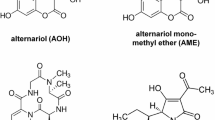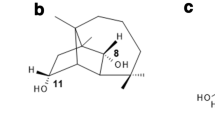Abstract
Treatment, for 1 h, of cultured Chinese hamster V79 cells, human liver HepG2 cells, and human colon HT-29 cells with theAlternaria toxins alternariol (AOH) and alternariol methyl ether (AME) caused a concentration-dependent induction of DNA strand breaks at concentrations ranging from 5 to 50 micromolar. After treatment for 24 h, DNA strand breaks were observed in HepG2 but not HT-29 cells. Analysis of the 24 h-incubation media of HT-29 cells showed that both toxins were completely conjugated, whereas 75% were still present as unconjugated compounds in the 24 h-media of HepG2 cells. Lysates of both cell types fortified with UDPGA were found to convert both toxins into two glucuronides each, but HT-29 cells exhibited a much high activity than HepG2 cells and gave rise to a different ratio of glucuronides. It is concluded that glucuronidation eliminates the DNA strandbreaking potential of AOH and AME, and that the two glucuronides of eachAlternaria toxin are generated by different UGT isoforms.
Similar content being viewed by others
References
Chelkowski J, Visconti A (eds) (1992)Alternaria. Biology, Plant Diseases and Metabolites. Elsevier, Amsterdam.
Scott PM (2001) Analysis of agricultural commodities and foods forAlternaria mycotoxins. J AOAC International 84: 1809–1817
Scott PM, Lawrence GA, Lau BPY (2006) Analysis of wines, grape juices and cranberry juices forAlternaria toxins. Mycotoxin Research 22: 142–147
Liu GT, Qian YZ, Zhang P, Dong WH, Qi YM, Guo HT (1992) Etiological role ofAlternaria alternala in human esophageal cancer. Chinese MedJ 105: 394–400
Lehmann L, Wagner J, Metzler M (2006) Estrogenic and clastogenic potential of the mycotoxin alternariol in cultured mammalian cells. Food Chem Toxicol 44: 398–408
Brugger EM, Wagner J, Schumacher DM, Koch K, Podlech J, Metzler M, Lehmann L (2006) Mutagenicity of the mycotoxin alternariol in cultured mammalian cells. Toxicol Lett 164: 221–230
Fehr M, Pahlke G, Fritz J, Marko D (2007) Alternariol acts as a topoisomerase poison. 29th Mycotoxin Workshop, Fellbach, Germany. Abstract Book p 123
Koch K, Podlech J, Pfeiffer E, Metzler M (2005) Total synthesis of alternariol. J Org Chem 70: 3275–3276
Pfeiffer E, Hoehle SI, Walch SG, Riess A, Sólyom AM, Metzler M (2007) Curcuminoids form reactive glucuronides in vitro. J Agric Food Chem 55: 538–544
Hartwig A, Dally H, Schlepegrell R (1996) Sensitive analysis of oxidative DNA damage in mammalian cells: use of the bacterial Fpg protein in combination with alkaline unwinding. Toxicol Lett 88: 85–90
Doehmer J (1993) V79 Chinese hamster cells genetically engineered for cytochrome P450 and their use in mutagenicity and metabolism studies. Toxicology 82: 105–118
Wooster R, Ebner T, Sutherland L, Clarke D, Burchell B (1993) Drug and xenobiotic glucuronidation catalzed by cloned human liver UDP-glucuronosyltransferases stably expressed in tissue culture cell lines. Toxicology 82:119–129
Caron P, Trottier J, Verreault M, Bélanger J, Kaeding J, Barbier B (2006) Enzymatic produc tion of bile acid glucuronides used as analytical standards for liquid chromatography-mass spectrometry analysis. Mol Pharm 3: 293–302
Jansen GH, Nielen MW, Müller M, Hollinan PC, Keijer J (2005) Uptake and metabolism of enterolactone and enterodiol by human colon epithelial cells. Arch Biochem Biophys 435: 74–82
Olsen M, Visconti A (1988) Metabolism of alteraariol monomethyl ether by porcine liver and intestinal mucosain vitro. Toxicol in Vitro 2: 27–29
Basu NK, Kole L, Kubota S, Owens IS (2004) Human UDP-glucuronosyltransferases show atypical metabolism of mycophenolic acid and inhibition by curcumin. Drag Metab Dispos 32: 768–773
Author information
Authors and Affiliations
Corresponding author
Additional information
Financial support: State of Baden-Württemberg (Research Program “Mycotoxins” as part of the Research Initiative “Food and Health”)
Rights and permissions
About this article
Cite this article
Pfeiffer, E., Eschbach, S. & Metzler, M. Alternaria toxins: DNA strand-breaking activity in mammalian cellsin vitro . Mycotox Res 23, 152–157 (2007). https://doi.org/10.1007/BF02951512
Received:
Accepted:
Issue Date:
DOI: https://doi.org/10.1007/BF02951512




